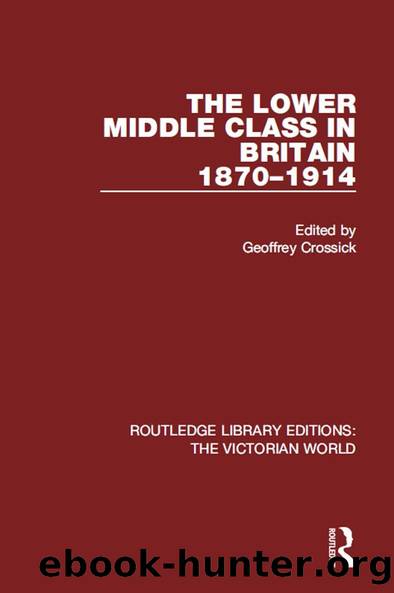The Lower Middle Class in Britain 1870-1914 by Geoffrey Crossick

Author:Geoffrey Crossick [Crossick, Geoffrey]
Language: eng
Format: epub
ISBN: 9781138645608
Barnesnoble:
Publisher: Taylor & Francis
Published: 2017-11-28T00:00:00+00:00
4 THE SOCIAL ECONOMY OF LATE-VICTORIAN CLERKS
G. L. Anderson
Of all the lower middle class groups which expanded with the structural shift in the late-Victorian economy from manufacturing to services, clerks were by far the most numerous and important. In 1861 only 91,733 men and virtually no women were employed as clerks; by 1891 there were 370,433 men and 18,947 women but by 1911 with 561,155 men and 124,843 women, clerks represented one of the largest and fastest-growing occupational groups in society.1 The majority of these clerks were employed in commerce, banking and insurance and were responsible for servicing that network of financial and commercial institutions which developed after 1870 in response to the growth of multilateral trade and the export of British capital. Moreover, the clerksâ economic role in staffing the service economy was matched by their social role as the most numerous of the expanding new suburban middle class in the cities. However, despite their economic and social importance, clerks have too easily come to be regarded merely as archetypal stereotypes of their age and even as cliché figures, a development largely caused by the popular image of the clerk being derived from such contemporary literary sources as Dickens and the Grossmiths. Unfortunately historians, until recently anyway, have failed to provide a more objective treatment of the lower middle class and have strangely neglected clerks along with other emerging white collar groups in the nineteenth century.2
The main purpose of this essay is, therefore, to examine an important and previously neglected occupational group. It is not intended, however, even if it were feasible within the present limitations of space, to provide a âtotalâ picture of clerksâ economic and social lives. There is little here of the domestic and leisure activities of clerks. Rather the essay sets out to explore their work and market situation and suggests that in the period after 1870, coinciding with the Great Depression and the downturn in British economic performance, many clerks in the face of new economic pressures were placed in an increasingly marginal position.
Not all clerks, of course, experienced these economic pressures to the same extent, or even at all, because clerks did not represent a uniform or homogeneous occupational group. There were, in fact, innumerable gradations of clerks covering a very wide spectrum of ability, career prospects, job type, status and remuneration. Moreover these differences occurred within firms and industries as well as between them. There was, therefore, a wide gulf indeed between such sought-after positions in the office hierarchy as corresponding clerkships, which involved a close working relationship with the employer and a thorough understanding of most aspects of a firmâs business and the routine clerkships which normally involved a familiarity with only part of the business procedure. Similarly those occupying routine but established clerkships were in a much more secure position, both in actual and status terms, within the office hierarchy than those apprentices and office boys, many of whom were employed on a short-term basis, at the bottom of the structure.
Download
This site does not store any files on its server. We only index and link to content provided by other sites. Please contact the content providers to delete copyright contents if any and email us, we'll remove relevant links or contents immediately.
Harry Potter and the Goblet Of Fire by J.K. Rowling(3025)
Never by Ken Follett(2873)
Shadow of Night by Deborah Harkness(2710)
Ogilvy on Advertising by David Ogilvy(2678)
Zero to IPO: Over $1 Trillion of Actionable Advice from the World's Most Successful Entrepreneurs by Frederic Kerrest(2377)
The Man Who Died Twice by Richard Osman(2291)
Machine Learning at Scale with H2O by Gregory Keys | David Whiting(2269)
Book of Life by Deborah Harkness(2259)
How Proust Can Change Your Life by Alain De Botton(2256)
My Brilliant Friend by Elena Ferrante(2219)
0041152001443424520 .pdf by Unknown(2214)
The Tipping Point by Malcolm Gladwell(2202)
How to Pay Zero Taxes, 2018 by Jeff A. Schnepper(2095)
Will by Will Smith(2033)
Purple Hibiscus by Chimamanda Ngozi Adichie(1979)
Hooked: A Dark, Contemporary Romance (Never After Series) by Emily McIntire(1933)
Borders by unknow(1780)
Rationality by Steven Pinker(1761)
Daughter of Smoke and Bone by Laini Taylor(1738)
